People who own enormous, usually antique "ship saws" are often traditional craftspeople doing big business in big wooden boats. Naturally, then, there are ship saws in and around Port …
This item is available in full to subscribers.
We have recently launched a new and improved website. To continue reading, you will need to either log into your subscriber account, or purchase a new subscription.
If you had an active account on our previous website, then you have an account here. Simply reset your password to regain access to your account.
If you did not have an account on our previous website, but are a current print subscriber, click here to set up your website account.
Otherwise, click here to view your options for subscribing.
* Having trouble? Call our circulation department at 360-385-2900, or email our support.
Please log in to continue |
|
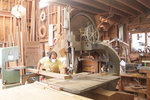
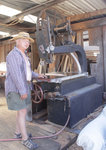
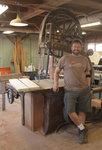
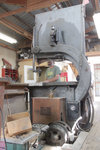
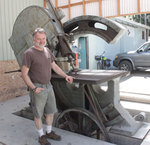
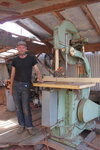
People who own enormous, usually antique "ship saws" are often traditional craftspeople doing big business in big wooden boats. Naturally, then, there are ship saws in and around Port Townsend.
Unlike a regular band saw, which has a table that can be set at different angles, with a ship saw, the whole thing tilts while the table stays flat.
"It's what [the saws] do that's amazing," said Port Townsend shipwright Dave Thompson. "The table stays flat, so when you're cutting things you don't have to try to hold it on a tilting table."
Thompson's ship saw is a Turner. "It’s fairly modern, with ball-and-roller bearings," he said, guessing its weight to be approximately 2.5 tons. He bought it in Bremerton for $1,500 about 10 years ago, and estimates it was built in the 1940s. "When we're busy doing planking, we use it all the time," he said.
With its 42-inch wheel, the saw has a capacious throat – it can accommodate a plank that's 42 inches wide. To set the blade angle, a lever operates the air-powered tilting mechanism, which leans the whole machine, with the enormous wheels spinning the blade – up to a 45-degree angle.
Wrapped in a white tarp nearby is another ship saw, an older one manufactured by J.A. Fay & Egan Co. of Cincinnati, Ohio. It has Babbitt bearings, a 48-inch wheel and stands 14 feet tall when it's put together. Thompson's partner, Al Katz, hopes to sell it for $5,000.
Nearby, another shipwright, Clint Thompson (no relation), has a ship saw made by The Crescent Machine Co. in Columbiana, Ohio.
SHIPWRIGHTS CO-OP
Dave Thompson, a former Port of Port Townsend commissioner, was also a cofounder in the 1980s of the Port Townsend Shipwrights Co-op, whose logo features an image of a ship saw.
He and Richard Wilmore, "much to the consternation of the rest of the crew," paid about $2,000 for the co-op's ship saw, which is now featured in the Shipwrights Co-op logo. "That's so much money!" Thompson remembers his fellow co-op shipwrights saying.
They bought that saw from Harvey Petrich at Western Boat Building Co. in Tacoma, where it may have been used in the construction of the Western Flyer, a fishing boat made famous by American author John Steinbeck. The vessel is currently being restored by the PT Shipwrights Co-op at its new facility, the former Admiral Marine Works and Townsend Bay Marine location. Perhaps the boat "remembers" the saw. Jim Lyons, another co-op cofounder, said that ship saw is used "every day, practically. It's the workhorse of big timber structural woodwork."
SCOW BAY BOATS
The co-op's saw has a twin nearby at Scow Bay Boats, owned by Mark Stout. He bought the building and the saw, which is bolted to a cement foundation under the floor, from Arren Day, who has since joined the Shipwrights Co-op. Like that of the co-op's saw, Stout's ship saw's angle is set mechanically by turning a large handle. An embossed plaque on the side states it was built by the Crescent Machine Co. in Leetonia, Pennsylvania, and gives a patent date: March 8, 1906. Stout's saw also has an Alaska Packers Association number, suggesting it was used in the Alaskan fishing fleet. Day bought it from Tim Hoffman of Steelhead Marine several years ago for $2,500.
"Jan and Steve Langhorst had it in town for a long time," said machinist Barry Stephens of Stephens Marine in Port Townsend. Stephens said he's going to do some work on Stout's saw, fixing the lower guide control arm for the blade.
Stephens has lately been reconfiguring a Hitachi resaw for Port Townsend shipwright Bob Cunningham, adding a tilt-drive mechanism to turn the resaw into a ship saw.
Day said he plans to design a portable ship saw with a 14-inch wheel that one person could use.
CAPE GEORGE MARINE WORKS
"I've always been kind of obsessed with old-fashioned cast-iron machinery," said Todd Uecker of Cape George Marine Works.
Several years ago, he bought a ship saw at a government auction for $2,500. A J.A. Fay & Egan 311 Lightning, with ball bearings, it had been used at Puget Sound Naval Shipyard in Bremerton. It's powered by a 20-horsepower electric motor, and the saw can tilt 45 degrees in both directions. The 311 Lightnings were built in the 1920s and ’30s in Cincinnati, Ohio.
Uecker hasn't used it yet.
"We build fiberglass boats here," he reasoned. He plans to modernize the saw when he finds the time, adding a modern motor and drive guards; as is, "it's way subpar on safety." Uecker plans to add a resaw attachment, which allows planks to be cut into thin veneers and is "the main excuse to have this saw." It's just "sculpture" now, he said. "It's an ongoing, back-burner project."
After it sat on a pallet for a few years, Uecker installed his ship saw in a custom concrete pit, which he built according to specifications received from a friend at Mystic Seaport in Connecticut. The friend documented his business's ship saw pit. About three years ago, Uecker's crew rented a backhoe, dug the hole, cast the pillars and set the saw in the foundation. "It's soon to be functional," Uecker said.
HAVEN BOATWORKS
The ship saw at Haven Boatworks can also tilt to cut angles up to 45 degrees with the use of a pneumatic foot pedal, which makes it easier for one person alone to cut a rolling bevel, an angled edge that changes over the length of the plank.
Haven's ship saw, built by American Wood Working Machinery Co. in Williamsport, Pennsylvania, came with the building; it was acquired for PT by Ernie Baird, whose Baird Boatworks was one of the first companies positioned to benefit when the port expanded to a 300-ton vessel haulout system.
Baird bought the saw in 1995 from Seattle shipwright Frank Prothero.
Baird recalled asking to buy Prothero's saw for several years before Prothero decided to sell. "It was like courting his daughter. Every time I went to Seattle, I'd stop by his shop, sit down and have a cup of coffee," Baird said. "It was a pleasure to be with Frank. Eventually, I'd ask for the saw, and he'd say, 'No, get out of here.'"
Then one day Prothero called him and said, "Come get the saw." He wanted $3,000.
Baird sent Andy Whitman and Jay Brevik to pick up the saw. "Andy and Jay came back with the wheels, the table and the motor," Baird said. "Andy looked at me and told me, in words of one syllable, 'If you think we can lift the carcass of that saw with just two people and a hand truck, you're out of your mind.'"
In the meantime, Baird said, Prothero, who was diabetic, had lost his vision and a leg, and wasn't able to get to work anymore. His shop was on a 110-foot barge on Lake Union. "During his absence, the barge was not well maintained," Baird said, speculating that oil or fuel may have gotten into the bilge, which caught fire when the bilge pump sparked. The barge burned on Dec. 20, 1995.
"It wasn't terminal for the saw," Baird said of the fire, "because all the parts that might have been damaged had already been brought back by Andy and Jay."
Baird said, "I was going to get the darn thing." He asked a neighboring business, Lake Union Drydock Co., for help, and "they were very sympathetic, very nice about it." They only charged Baird $500 to pick the saw off the barge with their barge-loaded crane.
"The next really fortunate circumstance," Baird said, "there was a fellow who worked in my shop, just a brilliant mechanic, Walt Trisdale. Walt re-poured the bearings for the wheels, and re-poured all of the bearings that controlled the turning mechanism, which is quite elaborate."
As a testament to Trisdale's skill, the saw passes the nickel test, Baird said, which is the traditional way of proving a saw doesn't vibrate. Stand a nickel on its edge on the table while the saw is running, and if it doesn't fall over, it passes the nickel test. "Walt's a heck of a mechanic."
Baird estimates that the saw weighs "all of 1,500 pounds, maybe a ton.
"When we got the saw, we had a fellow named Bill Matthews. He cut a hole in the floor and poured a concrete foundation that the support for the saw would rest on. It was so darn heavy, we had to pour a foundation and support the floor underneath it."
He doesn't know where or when the saw was built, but said a "commonsense guess is that it was built during that period of prosperity after World War I and prior to the Depression. These things track the American economy amazingly well."
BOAT SCHOOL
The Northwest School of Wooden Boatbuilding in Port Hadlock has a ship saw built in the 1930s by L. Power & Co. of Philadelphia. It has been temporarily donated by Rosario Straits Group Inc., a local project management company, which is also donating professional services and is currently housed in the boat school's new milling room, a 1,000-square-foot addition to the Hammond Building that allows noise and dust management.